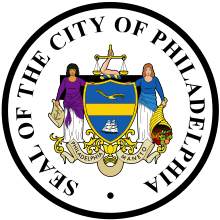Philadelphia Phillies
| Philadelphia Phillies | |||||
|---|---|---|---|---|---|
|
| |||||
| Established in 1883 | |||||
| |||||
| Major league affiliations | |||||
| |||||
| Current uniform | |||||
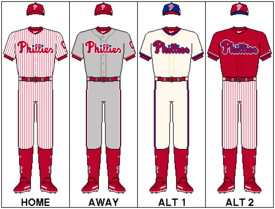 | |||||
| Retired numbers | |||||
| Colors | |||||
| Name | |||||
| Other nicknames | |||||
| Ballpark | |||||
| |||||
| Major league titles | |||||
| World Series titles (2) | |||||
| NL Pennants (7) | |||||
| East Division titles (11) | |||||
|
The Phillies also qualified for the postseason in the strike-split 1981 season, losing to the Montreal Expos in the NLDS. | |||||
| Front office | |||||
| Owner(s) | Phillies limited partnership (John S. Middleton (Principal Owner),[6] Jim & Pete Buck, David Montgomery, Pat Gillick)[7] | ||||
| Manager | Gabe Kapler | ||||
| General Manager | Matt Klentak | ||||
| President of Baseball Operations | Andy MacPhail | ||||
The Philadelphia Phillies are an American professional baseball team based in Philadelphia, Pennsylvania. The Phillies compete in Major League Baseball (MLB) as a member club of the National League (NL) East division. Since 2004, the team's home has been Citizens Bank Park, located in South Philadelphia.
The Phillies have won two World Series championships (against the Kansas City Royals in 1980 and the Tampa Bay Rays in 2008) and seven National League pennants, the first of which came in 1915. The franchise has also experienced long periods of struggle. Since the first modern World Series was played in 1903, the Phillies played 77 consecutive seasons (and 97 seasons from the club's establishment) before they won their first World Series—longer than any other of the 16 teams that made up the major leagues for the first half of the 20th century. The 77 season drought is the fourth longest World Series drought in Major League Baseball history. The longevity of the franchise and its history of adversity have earned it the dubious distinction of having lost the most games of any team in the history of American professional sports, and in fact was the first professional sports team in modern history to surpass 10,000 losses.[8] Despite the team's lack of success historically, they are one of the more successful franchises since the start of the Divisional Era in Major League Baseball. The Phillies have won their division 11 times, which ranks 6th among all teams and 4th in the National League, including five consecutive division titles from 2007 to 2011.
The franchise was founded in Philadelphia in 1883, replacing the team from Worcester, Massachusetts in the National League. The team has played at several stadiums in the city, beginning with Recreation Park and continuing at Baker Bowl; Shibe Park, which was later renamed Connie Mack Stadium in honor of the longtime Philadelphia Athletics manager; Veterans Stadium; and now Citizens Bank Park.
The team's spring training facilities are located in Clearwater, Florida, where its Class-A minor league affiliate Clearwater Threshers plays at Spectrum Field. Its Double-A affiliate is the Reading Fightin Phils, which plays in Reading, Pennsylvania; its Triple-A affliliate is the Lehigh Valley IronPigs, which plays in Allentown, Pennsylvania; and its Low Class-A affiliate the Lakewood Blueclaws play in Lakewood, New Jersey.
History
1883–1942: Early history

After being founded in 1883 as the "Quakers", the team changed its name to the "Philadelphias", after the convention of the times. This was soon shortened to "Phillies".[9] "Quakers" continued to be used interchangeably with "Phillies" from 1883 until 1890, when the team officially became known as the "Phillies". Though the Phillies moved into a permanent home at Baker Bowl in 1887,[10] they did not win their first pennant until nearly 30 years later, after the likes of standout players Billy Hamilton, Sam Thompson, and Ed Delahanty had departed. Player defections to the newly formed American League, especially to the cross-town Philadelphia Athletics, would cost the team dearly over the next several years. A bright spot came in 1915, when the Phillies won their first pennant, thanks to the pitching of Grover Cleveland Alexander and the batting prowess of Gavvy Cravath, who set what was then the modern major-league single-season record for home runs with 24.[11] Poor fiscal management after their appearance in the 1915 World Series, however, doomed the Phillies to sink back into relative obscurity; from 1918 to 1948 they only had one winning season. Though Chuck Klein won the Most Valuable Player Award in 1932 and the National League Triple Crown in 1933, the team continued to flounder at the bottom of the standings for years.[12]
1943–69: "Whiz Kids" and refusal to integrate


After lumber baron William B. Cox purchased the team in 1943, the Phillies rose out of the standings cellar for the first time in five years. As a result, the fan base and attendance at home games increased. But it soon became clear that not all was right in Cox's front office. Eventually Cox revealed that he had been betting on the Phillies and he was banned from baseball. The new owner, Bob Carpenter, Jr., scion of the Delaware-based DuPont family, tried to polish the team's image by unofficially changing its name to the "Bluejays". However, the new moniker did not take, and it was quietly dropped by 1949.[13]

Instead, Carpenter turned his attention to the minor league affiliates, continuing an effort begun by Cox a year earlier; prior to Cox's ownership, the Phillies had paid almost no attention to player development. This led to the advent of the "Whiz Kids", led by a lineup of young players developed by the Phillies' farm system that included future Hall of Famers Richie Ashburn and Robin Roberts.[14] Their 1950 season was highlighted by a last-day, pennant-clinching home run by Dick Sisler[15] to lead the Phillies over the Brooklyn Dodgers and into the World Series, where they were swept by the New York Yankees, four games to none (although each game was close).
In contrast, the Philadelphia Athletics finished last in 1950 and long-time manager Connie Mack retired. The team struggled on for four more years with only one winning season before abandoning Philadelphia under the Johnson brothers, who bought out Mack. They began play in Kansas City in 1955.[16] As part of the deal selling that team to the Johnson brothers, the Phillies bought Shibe Park, where both teams had played since 1938.[14]
Many thought that the Whiz Kids, with a young core of talented players, would be a force in the league for years to come.[17][18] However, it was not to be, as the team finished with a 73–81 record in 1951, and (except for 2nd-place tie in 1964) did not finish higher than third place again until 1975.[19] Their lack of success was partly blamed on Carpenter's unwillingness to integrate his team after winning a pennant with an all-white team. The Phillies were the last National League team to sign a black player, a full 10 years after Jackie Robinson made his debut for the Dodgers.[20] Their competitive futility was highlighted by a record that still stands: in 1961, the Phillies lost 23 games in a row, the worst losing streak in the majors since 1900.
The Phold of '64
|
|
Though Ashburn and Roberts were gone, the 1964 Phillies still had younger pitchers Art Mahaffey, Chris Short, and rookie Ray Culp; veterans Jim Bunning and screwballer Jack Baldschun; and fan favorites Cookie Rojas, Johnny Callison, and NL Rookie of the Year Richie Allen. The team was 90-60 on September 20, good enough for a six-and-a-half-game lead in the pennant race with 12 games to play. However, the Phillies lost 10 games in a row and finished one game out of first, losing the pennant to the St. Louis Cardinals. The "Phold of '64" is frequently mentioned as the worst collapse in sports history.[22]
One highlight of the season occurred on Father's Day, when Jim Bunning pitched a perfect game against the New York Mets, the first in Phillies history.[23]
1970–83: Building a winning team
.jpg)
At the end of the decade, in October 1970, the Phillies played their final game in Connie Mack Stadium and prepared to move into newly built Veterans Stadium, wearing new maroon uniforms to accentuate the change. While some members of the team performed admirably during the 1970s, the Phillies still clung to their position at the bottom of the National League standings. Ten years after "the Phold", they suffered another minor collapse in August and September 1974, missing out on the playoffs yet again. But the futility would not last much longer. They had a run of three straight division titles from 1976 to 1978.[26] That run was led by pitchers Steve Carlton, Gene Garber, outfielder Greg Luzinski, and infielders Mike Schmidt and Larry Bowa. The Phillies won the NL East in 1980 after the departure of Garber, but behind pitcher Steve Carlton, outfielder Greg Luzinski, and infielders Mike Schmidt, Larry Bowa, and recently acquired Pete Rose.
1980 World Series Champions
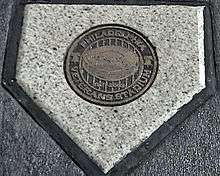
In a memorable NLCS, with four of the five games going into extra innings, they fell behind 2–1 but battled back to squeeze past the Houston Astros on a tenth-inning, game-winning hit by center fielder Garry Maddox, and the city celebrated its first pennant in 30 years.[27]
Facing the Kansas City Royals in the 1980 World Series, the Phillies won their first World Series championship ever in six games thanks to the timely hitting of Mike Schmidt and Pete Rose. Schmidt, who was the National League MVP that 1980 season, also won the World Series MVP award on the strength of his 8-for-21 hitting (.381 average), including game-winning hits in Game 2 and the clinching Game 6. This sixth, final game was also significant because it remains "the most-watched game in World Series history" with a television audience of 54.9 million viewers.[28]
Thus, the Phillies became the last of the 16 teams that made up the major leagues from 1901 to 1961 to win a World Series.[29]
1981–1983
After their Series win Ruly Carpenter, who was given control of the team in 1972 when his father stepped down as team president, sold the team to a group which was headed by long time Phillies executive Bill Giles for $32.5 million in 1981. The Phillies would return to the playoffs that season, in which the season was split in half due to a players' strike. They were defeated in the first ever National League Division Series by the Montreal Expos in five games. Mike Schmidt won his second consecutive NL MVP award that year. In 1982 the team finished 3 games behind the St. Louis Cardinals in the East Division narrowly missing the playoffs. Steve Carlton would capture his fourth career NL Cy Young Award that year with 23 wins. For the 1983 season the Phillies returned to the playoffs beating the Los Angeles Dodgers in the NLCS in four games to capture their fourth NL pennant. They lost to the Baltimore Orioles in the World Series in 5 games. John Denny was named the 1983 NL Cy Young Award winner.
1984–92: Fall from grace
Following their loss to the Orioles in the 1983 World Series the team would follow with near playoff misses and a rapid drop back into the basement of the National League over the next five seasons.[27] In 1989 Mike Schmidt retired from the Phillies and thus the last member of the 1980 championship team was gone.
Over the next three seasons the Phillies would continue to miss the playoffs and finished dead last in the majors for the 1992 season.
1993–2004: A near miss, recovery, and a new home
The 1993 Phillies started the season by going 17–5 in April and finishing with a 97–65 season. They beat the Atlanta Braves in the 1993 National League Championship Series, four games to two, to earn the fifth NL pennant in franchise history, only to be defeated by the defending World Series champion Toronto Blue Jays in the 1993 World Series.[30] Toronto's Joe Carter hit a walk-off home run in Game 6 to clinch another Phillies loss.[31]
The 1994–95 Major League Baseball strike was a blow to the Phillies' attendance and on-field success, as was the arrival of the Braves in the division due to league realignment. Several stars came through Philadelphia, though few would stay, and the minor league system continued to develop its young prospects, who would soon rise to Phillies fame.
In 2001, the Phillies had their first winning season in eight years under new manager Larry Bowa, and their season record would not dip below .500 again from the 2003 season onward.[32] In 2004, the Phillies moved to their new home, Citizens Bank Park,[33] across the street from the Vet.
2005–12: The Golden Era
Charlie Manuel took over the reins of the club from Bowa after the 2004 season, and general manager Ed Wade was replaced by Pat Gillick in November 2005. Gillick reshaped the club as his own, sending stars away in trades and allowing the Phillies' young core to develop. After the franchise lost its 10,000th game in 2007,[8] its core of young players, including infielders Chase Utley, Ryan Howard, and Jimmy Rollins and pitcher Cole Hamels, responded by winning the National League East division title, but they were swept by the Colorado Rockies in the Division Series.[34] After the 2007 season, they acquired closer Brad Lidge.
2008: Second World Series Championship
In 2008, the Phillies clinched their second straight division title[35] and defeated the Milwaukee Brewers in the Division Series to record the franchise's first post-season victory since winning the 1993 NLCS. Behind strong pitching from the rotation and stellar offensive production from virtually all members of the starting lineup, the Phillies won the 2008 National League Championship Series against the Los Angeles Dodgers; Hamels was named the series' Most Valuable Player. The Phillies would then go on to defeat the Tampa Bay Rays in 5 games for their second World Series title in their 126-year history. Hamels was named both NLCS MVP as well as World Series MVP after going 4–0 in the postseason that year.
2009–2012

Gillick retired as general manager after the 2008 season and was succeeded by one of his assistants, Rubén Amaro, Jr. After adding outfielder Raúl Ibañez to replace the departed Pat Burrell, the Phillies retained the majority of their core players for the 2009 season. In July, they signed three-time Cy Young Award winner Pedro Martínez and acquired 2008 American League Cy Young winner Cliff Lee before the trade deadline. On September 30, 2009, they clinched a third consecutive National League East Division title for the first time since the 1976–78 seasons. The team continued this run of success with wins over the Colorado Rockies in the NLDS (3 games to 1) and the Los Angeles Dodgers in the NLCS (4 games to 1), to become the first Phillies team to win back-to-back pennants and the first National League team since the 1996 Atlanta Braves to have an opportunity to defend their World Series title. The Phillies were unable to repeat the 2008 World Series victory; they were defeated in the 2009 series by the New York Yankees, 4 games to 2. In recognition of the team's recent accomplishments, Baseball America named the Phillies as its Organization of the Year.[36]
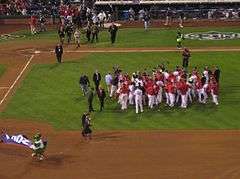
On December 16, 2009, they acquired starting pitcher Roy Halladay from the Toronto Blue Jays for three minor-league prospects,[37] and traded Cliff Lee to the Seattle Mariners for three prospects.[38] On May 29, 2010, Halladay pitched a perfect game against the Florida Marlins.[d]
In June 2010, the team's scheduled 2010 series against the Toronto Blue Jays at Rogers Centre was moved to Philadelphia, because of security concerns for the G-20 Summit. The Blue Jays wore their home white uniforms and batted last as the home team, and the designated hitter was used.[39] The game was the first occasion of the use of a designated hitter in a National League ballpark in a regular-season game; Ryan Howard was the first player to fill the role.[40]
The 2010 Phillies won their fourth consecutive NL East Division championship[41][42] despite a rash of significant injuries to key players, including Ryan Howard,[43] Chase Utley,[44] Jimmy Rollins,[45] Shane Victorino,[46] and Carlos Ruiz.[47] After dropping seven games behind the Atlanta Braves on July 21, Philadelphia finished with an MLB-best record of 97–65.[48] The streak included a 20–5 record in September, the Phillies' best September since winning 22 games that month in 1983,[49] and an 11–0 run in the middle of the month.[50] The acquisition of pitcher Roy Oswalt in early August was a key step, as Oswalt won seven consecutive games in just over five weeks from August 11 through September 17.[50] The Phillies clinched the division on September 27, behind a two-hit shutout by Halladay.[51]
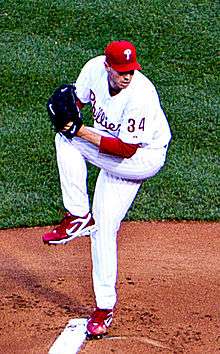
In Game 1 of the 2010 National League Division Series, Halladay threw the second no-hitter in Major League baseball postseason history, leading the Phillies over the Cincinnati Reds, 4–0. (The first was New York Yankee pitcher Don Larsen's perfect game in the 1956 World Series.[52]) Halladay's no-hitter was the fifth time a pitcher has thrown two no-hitters in the same season, and was also the first time that one of the two occurred in the postseason. The Phillies went on to sweep the Reds in three straight games. In the 2010 National League Championship Series, the Phillies fell to the eventual World Series champion San Francisco Giants in six games.
On September 17, 2011, the Phillies won their fifth consecutive East Division championship,[53] and on September 28, during the final game of the season, the team set a franchise record for victories in a season with 102 by beating the Atlanta Braves in 13 innings, denying their division rivals a potential wild card berth.[54] Yet the Phillies lost in the NLDS to the St. Louis Cardinals – the team that won the National League Wild Card as a result of the Phillies beating the Braves. The Cardinals subsequently beat the Brewers in the NLCS and won the 2011 World Series in 7 games over the Texas Rangers.
The 2012 Phillies experienced an up and down season. They played .500 ball through the first two months, but then slumped through a 9–19 stretch in June where they ended up at the bottom of the NL East by midseason. With any hope dimming, the Phillies traded key players Shane Victorino and Joe Blanton to the Los Angeles Dodgers, and Hunter Pence to the San Francisco Giants before the trade deadline. A hot start in the second half of the season put the Phillies back on the postseason hunt, but any hope was eventually extinguished with a loss to the Washington Nationals on September 28, costing the Phillies the postseason for the first time since 2006.
2013–present: Recent years
During the 2013 season, the team struggled again, and was unable to consistently play well for the majority of the season. On August 16, 2013, with the team's record at 53-68, the Phillies fired manager Charlie Manuel, who had managed the team since 2005,[55] and promoted third-base coach Ryne Sandberg to Interim Manager. Manuel had spent over nine years as manager, leading Philadelphia to its first World Series victory in nearly 30 years and amassing an overall record of 780-636 to become the manager with the most wins in the franchise's history. The 2013 Phillies ended up with a record of 73-89, their first losing season since 2002.
In 2015, Sandberg resigned as manager and bench coach Pete Mackanin was brought in as interim manager. Also in 2015 general manager Rubén Amaro, Jr. was fired and Andy MacPhail was brought in as the interim GM. [56]
In the 2014 season, one of the few bright spots was the September 1 game against a division rival, the Atlanta Braves, when starter Cole Hamels and relievers Jake Diekman, Ken Giles, and Jonathan Papelbon combined for a no-hitter in Turner Field and a 7-0 victory over Atlanta.
On June 16, 2015, veteran outfielder Jeff Francoeur was called in to pitch in an interleague game against the Baltimore Orioles in which the Orioles were winning 17-3 going into the seventh inning. Francoeur pitched two innings while giving up one hit, two runs (earned), three walks, and struck out one. The Phillies were forced to use Francoeur because they had used all other pitchers available for the night.
On July 25, 2015, in what would be his final start for the Phillies before being traded, Cole Hamels no-hit the Chicago Cubs 5–0 at Wrigley Field, striking out 13 and only giving up two walks, both to Dexter Fowler, and besting the Cubs' Jake Arrieta—himself a no-hit pitcher a month later, on August 30 of that season.[57] It was the first no-hitter against the Cubs since Sandy Koufax's perfect game in 1965, and first at Wrigley since the Cubs' Milt Pappas in 1972.[58]
On July 31, 2015, Cole Hamels was dealt to the Texas Rangers along with Jake Diekman and cash for Matt Harrison, Jerad Eickhoff, Jorge Alfaro, Nick Williams, Alec Asher, and Jake Thompson.[59][60]
On October 14, 2015 Andy MacPhail was officially named the 17th President of Baseball Operations in Philadelphia Phillies history.[61]
On September 29, 2017, Pete Mackannin was fired as manager of the Phillies. With only 3 games left, Mackannin would go on to finish managing the team until October 1, 2017.
On October 30, 2017, the Phillies announced Gabe Kapler as their new manager to succeed Mackanin. From November 2014 to the date he was hired as Phillies manager, Kapler was the Director of Player Development for the Los Angeles Dodgers.
Team uniform
Current uniform
The current team colors, uniform, and logo date to 1992. The main team colors are red and white, with blue serving as a prominent accent. The team name is written in red with a blue star serving as the dot over the "i"s, and blue piping is often found in Phillies branded apparel and materials. The team's home uniform is white with red pinstripes, lettering and numbering. The road uniform is traditional grey with red lettering/numbering. Both bear a script-lettered "Phillies" logo, with the aforementioned star dotting the "i"s across the chest, and the player name and number on the back. Hats are red with a single stylized "P".[64] The uniforms and logo are very similar to those used during the "Whiz Kids" era from 1950 to 1969.
The Phillies and their National League compadres the St. Louis Cardinals are the only teams in Major League baseball to utilize chain stitching in their chest emblem.
In 2008, the Phillies introduced an alternate, cream-colored uniform during home day games in tribute to their 125th anniversary. The uniforms are similar to those worn from 1946 through 1949, featuring red lettering bordered with blue piping and lacking pinstripes.[65] The accompanying cap is blue with a red bill and a red stylized "P." The uniforms were announced on November 29, 2007, when Phillies shortstop Jimmy Rollins, pitcher Cole Hamels, and Hall of Fame pitcher Robin Roberts modeled the new uniforms.[66]
For the 2009 season the Phillies added black, circular "HK" patches to their uniforms over their hearts in honor of broadcaster Harry Kalas, who died April 13, 2009, just before he was to broadcast a Phillies game. From Opening Day through July 26, 2009, the Phillies wore 2008 World Champions patches on the right sleeve of their home uniforms. In 2010, the Phillies added a black patch with a white "36" on the sleeves of their jerseys to honor Roberts, who died on May 6. Roberts' No. 36 had been previously retired by the team. In 2011, the Phillies added a black circular patch with a 'B' in honor of minority owners Alexander and John Buck, who died in late 2010. In 2015, the Phillies added a black circular patch with a white "SLB" in memory of minority owner Sara L. Buck, who died on August 23, 2014.
In 2016, the Phillies added a red alternate uniform, similar to their spring training uniforms, to be used for mid-week afternoon games. It was retired in 2018, after which the Phillies revived their powder blue throwbacks as an alternate uniform to be used on select Thursday home games.
The Phillies are one of four teams in Major League Baseball that do not display the name of their city, state, or region on their road jerseys, joining the Los Angeles Angels of Anaheim, St. Louis Cardinals, and the Tampa Bay Rays. The Phillies are the only team that also displays the player's number on one sleeve except on the alternate jersey, in addition to the usual placement on the back of the jersey.
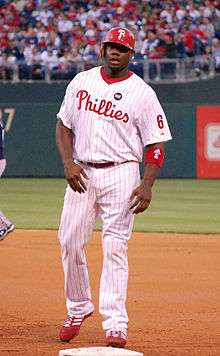
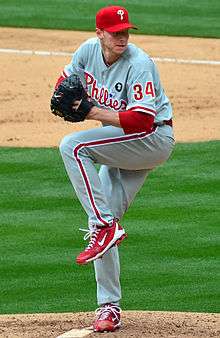

Batting practice
The Phillies were an early adopter of the batting practice jersey in 1977, wearing a maroon v-necked top with the "Phillies" script name across the chest, as well as the player name and number on the back and a player number on the left sleeve, all in white. Larry Bowa, Pete Rose, and Mike Schmidt wore this maroon batting jersey in place of their road jersey during the 1979 All-Star Game in Seattle. Currently, during spring training, the Phillies wear solid red practice jerseys with pinstriped pants for Grapefruit League home games. The red jerseys are worn with grey pants on the road.
Former uniforms
From 1970 to 1991, the Phillies sported colors, uniforms, and a logo that were noticeably different from what had come before, or since, but that were widely embraced by even traditionally minded fans. A dark burgundy was adopted as the main team color, with a classic pinstripe style for home uniforms. Blue was almost entirely dropped as part of the team's official color scheme, except in one area; a pale blue (as opposed to traditional grey) was used as the base-color for away game uniforms from 1972 to 1988. Yet the most important aspect of the 1970 uniform change was the adoption of one of the more distinctive logos in sports; a Phillies "P" that, thanks to its unique shape and "baseball stitched" center swirl, remained instantly recognizable and admired, long after its regular use had ended. It was while wearing this uniform style and color motif that the club achieved its most enduring success, including a World Series title in 1980 and another World Series appearance in 1983.[64] Its continued popularity with fans is still evident, as even today Phillies home games can contain many fans sporting caps, shirts, and/or jackets emblazoned with the iconic "P" and burgundy color scheme. The current Phillies team has worn the burgundy and powder blue throwbacks whenever their opponents are wearing throwback uniforms from that era.
Controversial uniform changes
In 1979, the Phillies front office modified the uniform into an all-burgundy version with white trimmings, to be worn for Saturday games.[67] They were called "Saturday Night Specials" and were worn for the first and last time on May 19, 1979,[68] a 10–5 loss to the Expos.[69] The immediate reaction of the media, fans, and players alike was negative, with many describing the despised uniforms as pajama-like. As such, the idea was hastily abandoned.[70] Mike Schmidt did wear the uniform during the MLB All-Star Tour of Japan following the 1979 season. The final appearance on field (to date) of this uniform was during the closing ceremonies at Veterans Stadium on September 28, 2003. There was a rather large procession of players during the post game ceremony, most in uniform. Former pitcher Larry Christenson, the starting pitcher in the original game, came out wearing this old burgundy uniform, and was the only one to do so.
Another uniform controversy arose in 1994 when the Phillies introduced blue caps on Opening Day which were to be worn for home day games only.[71] The caps were unpopular with the players, who considered them bad luck after two losses and wanted them discontinued. Management wanted to keep using the caps as planned, as they sold well among fans. A compromise was reached as the players agreed to wear them for weekday games while returning to the customary red caps for Sunday afternoon games.[72] In all, the Phillies wore the "unlucky" blue caps for seven games in 1994, losing six (the lone victory a 5-2 triumph over the Florida Marlins on June 29).[73] A different blue cap was introduced in 2008 as part of the alternate home uniform for day games, a throwback to the late 1940s.
Rivalries
New York Mets

The rivalry between the New York Mets and the Phillies was said to be among the "hottest" rivalries in the National League.[74][75] The two National League East divisional rivals have met each other recently in playoff, division, and wild card races.
Aside from several brawls in the 1980s, the rivalry remained low-key before the 2006 season,[76] as the teams had seldom been equally good at the same time. Since 2006, the teams have battled for playoff position. The Mets won the division in 2006 and contended in 2007 and 2008, while the Phillies won five consecutive division titles from 2007 to 2011.[77] The Phillies' 2007 Eastern Division Title was won on the last day of the season as the Mets lost a seven-game lead with seventeen games remaining.
Atlanta Braves
Although the rivalry lacks the hatred of the Mets, it has been the more important one in the last decade. Since the realignment of the divisions, the Phillies and Braves have been the most consistent champions of the National League East. While rivalries are generally characterized by mutual hatred, the Braves and Phillies deeply respect each other. Each game played (18 games in 2011) is vastly important between these two NL East giants, but at the end of the day, they are very similar organizations.[78] Overall, the Braves and the Phillies have the most National League East division titles, with the Braves having won 12 times, and the Phillies having won 11 times each since 1969, with the Braves holding it for eleven consecutive years from 1995 through 2005.
Historical rivalries
Pittsburgh Pirates
The rivalry between the Phillies and the Pittsburgh Pirates was considered by some to be one of the best rivalries in the National League.[79][80][81] The rivalry started when the Pittsburgh Pirates entered National League play in their fifth season of 1887, four years after the Phillies.[82]
The Phillies and the Pirates had remained together after the National League split into two divisions in 1969. During the period of two-division play (1969 to 1993), the two National League East division rivals won the two highest numbers of division championships, reigning exclusively as NL East champions in the 1970s and again in the early 1990s,[82][83] the Pirates 9, the Phillies 6; together, the two teams' 15 championships accounted for more than half of the 25 NL East championships during that span.[84]
After the Pirates moved to the National League Central in 1994, the teams face each other only in two series each year and the rivalry has diminished.[81] However, many fans, especially older ones, retain their dislike for the other team and regional differences between Eastern and Western Pennsylvania still fuel the rivalry.[85] The rivalry between the Philadelphia Flyers and the Pittsburgh Penguins in the National Hockey League is also fiercely contested.[85][86]
City Series: Philadelphia Athletics
The City Series was the name of a series of baseball games played between the Philadelphia Athletics of the American League and the Phillies that ran from 1903 through 1955. After the A's move to Kansas City, Missouri in 1955, the City Series rivalry came to an end. The teams have since faced each other in Interleague play (since its introduction in 1997) but the rivalry has effectively died in the intervening years since the A's left Philadelphia. In 2014, when the A's faced the Phillies in inter-league play at O.Co Coliseum, the Athletics didn't bother to mark the historical connection, going so far as to have a Connie Mack promotion the day before the series while the Texas Rangers were in Oakland.[87]
The first City Series was held in 1883 between the Phillies and the American Association's Athletics.[88] When the Athletics first joined the American League, the two teams played each other in a spring and fall series. No City Series was held in 1901 and 1902 due to legal warring between the National and American Leagues.
Current roster
Achievements
Awards
Five Phillies have won MVP awards during their career with the team. Mike Schmidt leads with three wins, with back-to-back MVPs in 1980 and 1981, and in 1986 as well. Chuck Klein (1932), Jim Konstanty (1950), Ryan Howard (2006), and Jimmy Rollins (2007) all have one.[89] Pitcher Steve Carlton leads the team in Cy Young Award wins with four (1972, 1977, 1980, and 1982), while John Denny (1983), Steve Bedrosian (1987), and Roy Halladay (2010) each have one.[89] Four Phillies have won Rookie of the Year honors as well. Jack Sanford won in 1957, and Dick Allen won in 1964. Third baseman Scott Rolen brought home the honors in 1997, while Howard was the most recent Phillies winner in 2005.[90] In doing so, Howard became only the second player in MLB history to win Rookie of the Year and Most Valuable Player in consecutive years, Cal Ripken, Jr. of the Baltimore Orioles being the first.[91]
Of the 15 players who have hit four home runs in one game, three were Phillies at the time (more than any other team).[92] Ed Delahanty was the first, hitting his four in Chicago's West Side Park on July 13, 1896. Chuck Klein repeated the feat nearly 40 years later to the day, on July 10, 1936, at Pittsburgh's Forbes Field. Forty years later, on April 17, 1976, Mike Schmidt became the third, also hitting his in Chicago, these coming at Wrigley Field.
Team captains
- Jimmy Wilson 1927–1928
- Fresco Thompson 1928–1930
- Granny Hamner 1952–1959
- Mike Schmidt 1978–1979
Wall of Fame
From 1978 to 2003, the Phillies inducted one former Phillie and one former member of the Philadelphia Athletics per year. Since 2004 they have inducted one Phillie annually. Players must be retired and must have played at least four years with the Phillies or Athletics. The last ten years' inductees to the Wall of Fame are listed below (note that there was no inductee for the 2017 season, as Pete Rose was intended to be inducted, but was not due to controversial allegations):

| Philadelphia Baseball Wall of Fame | |||||
|---|---|---|---|---|---|
| Inducted | Player | Position | Years | Ref | |
| 2006 | Dallas Green | P MGR |
1960–1967 1979–1981 |
[93][94] | |
| 2007 | John Vukovich | INF CO EXEC |
1970–1971, 1976–1981 1988–2004 2004–2007 |
[95] | |
| 2008 | Juan Samuel | 2B CO |
1983–1989 2011–2017 |
[96] | |
| 2009 | Harry Kalas |
TV | 1971–2009 | [97] | |
| 2010 | Darren Daulton | C | 1983 1985–1997 |
[98] | |
| 2011 | John Kruk | 1B TV |
1989–1994 2017–present |
[99] | |
| 2012 | Mike Lieberthal | C | 1994–2006 | [100] | |
| 2013 | Curt Schilling | P | 1992–2000 | [101] | |
| 2014 | Charlie Manuel | MGR | 2005–2013 | [102] | |
| 2015 | Pat Burrell | OF | 2000–2008 | ||
| 2016 | Jim Thome |
1B | 2003–2005, 2012 | ||
| 2017 | no inductees–see Pete Rose | ||||
| 2018 | Pat Gillick |
GM EXEC |
2005–2008 2008–present |
[103] | |
| 2018 | Roy Halladay | P | 2010–2013 | [104] | |
Centennial Team
In 1983, rather than inducting a player into the Wall of Fame, the Phillies selected their Centennial Team, commemorating the best players of the first 100 years in franchise history.
Philadelphia Sports Hall of Fame
| Phillies in the Philadelphia Sports Hall of Fame | |||||
|---|---|---|---|---|---|
| No. | Name | Position | Tenure | Inducted | Notes |
| — | By Saam | Broadcaster | 1939–1950 1955–1975 | 2014 | |
| — | Bill Campbell | Broadcaster | 1963–1970 | 2005 | |
| — | Harry Kalas | Broadcaster | 1971–2009 | 2004 | |
| — | Dan Baker | P.A. Announcer | 1972–present | 2012 | |
| — | Grover Cleveland Alexander | P | 1911–1917, 1930 | 2005 | |
| — | Chief Bender | P | 1916–1917 | 2014 | Elected mainly on his performance with Philadelphia Athletics |
| — | Ed Delahanty | LF | 1891–1901 | 2008 | |
| — | Sam Thompson | RF | 1889–1898 | 2015 | |
| 1 | Richie Ashburn | CF Broadcaster | 1948–1959 1963–1997 | 2004 | |
| 1, 3, 8, 14, 26, 29, 32, 36 | Chuck Klein | RF | 1928–1933 1936–1939 1940–1944 | 2007 | |
| 6 | Johnny Callison | RF | 1960–1969 | 2012 | |
| 8, 40 | Bob Boone | C | 1972–1981 | 2017 | |
| 10 | Larry Bowa | SS Coach Manager | 1970–1981 2001–2004 1989–1996 2014–present | 2009 | |
| 14 | Del Ennis | OF | 1946–1956 | 2006 | Grew up in the Crescentville section of Philadelphia |
| 15, 32 | Dick Allen | 1B / 3B | 1963–1969 1975–1976 | 2010 | |
| 17, 20, 35, 40 | Bucky Walters | P / 3B | 1934–1938 | 2013 | Elected mainly on his performance with Cincinnati Reds, born and raised in Philadelphia |
| 19 | Greg Luzinski | LF | 1970–1980 | 2013 | |
| 20 | Mike Schmidt | 3B | 1972–1989 | 2004 | |
| 28, 32 | Curt Simmons | P | 1947–1960 | 2011 | |
| 31 | Garry Maddox | CF | 1975–1986 | 2015 | |
| 32 | Steve Carlton | P | 1972–1986 | 2004 | |
| 36 | Robin Roberts | P | 1948–1961 | 2004 | |
| 38 | Curt Schilling | P | 1992–2000 | 2014 | |
| 41 | Chris Short | P | 1959–1972 | 2016 | |
| 41 | Charlie Manuel | Manager | 2005–2013 | 2016 | |
| 45 | Tug McGraw | P | 1975–1984 | 2010 | |
Hall of Famers
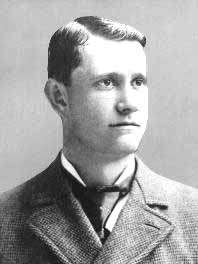
- See footnote[105]
| Philadelphia Phillies Hall of Famers |
|---|
| Affiliation according to the National Baseball Hall of Fame and Museum |
|
Ford C. Frick Award recipients
| Philadelphia Phillies Ford C. Frick Award recipients | |||||||||
|---|---|---|---|---|---|---|---|---|---|
| Affiliation according to the National Baseball Hall of Fame and Museum | |||||||||
|
Retired numbers and other honors
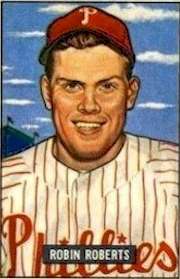
The Phillies have retired six numbers, and honored two additional players with the letter "P."[107] Grover Cleveland Alexander played with the team in the era before Major League Baseball used uniform numbers, and Chuck Klein wore a variety of numbers with the team during his career. Of the six players with retired numbers, five were retired for their play with the Phillies and one, 42, was universally retired by Major League Baseball when they honored the 50th anniversary of Jackie Robinson's breaking the color barrier.
|
Community
Charitable contributions
The Phillies have supported amyotrophic lateral sclerosis research (also known as Lou Gehrig's disease) with the "Phillies Phestival" since 1984.[116] The team raised over US$750,000 for ALS research at their 2008 festival, compared with approximately $4,500 at the inaugural event in 1984;[116] the event has raised a total of over $10 million in its history.[117] The ALS Association of Philadelphia is the Phillies' primary charity,[118] and the hospitals they support include Pennsylvania Hospital, Thomas Jefferson University Hospital, and Hahnemann University Hospital.[116] Former Phillies pitchers Geoff Geary (now with the Houston Astros), who lost a friend to the disease,[119] and Curt Schilling, who retired with the Boston Red Sox,[120] are both still involved with the Phillies' cause.
Phanatic about Education
The Philadelphia Phillies have shown themselves to be a big supporter of reading and overall education, using baseball in a positive way to help support education for students. The Phillies have a reading incentive program called Phanatic About Reading, which is designed to encourage students from kindergarten to eighth grade to read for a minimum of 15 minutes a night. This reading program is to help students with their literacy skills and comprehension. Phillies Phundamentals is another educational program, offered through after-school and summer camps, that is designed to make learning fun and support academic skills by using baseball.
The Phillies celebrate teachers during their annual Teacher Appreciation Night.[121]
Fan support and reputation
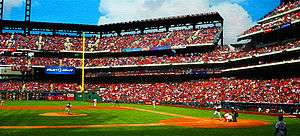
- See footnote[122]
Phillies fans have earned a reputation over the years for their occasional unruly behavior. In the 1960s, radio announcers for visiting teams would frequently report on the numerous fights breaking out in Connie Mack Stadium.[123] Immediately after the final game at the old park, many fans ran onto the field or dislodged parts of the ballpark to take home with them.[124] Later, at Veterans Stadium, the 700 Level gained a reputation for its "hostile taunting, fighting, public urination and general strangeness."[125] Phillies fans famously are known for their reputation of being the "Meanest Fans in America".[126]
Phillies fans are known for harsh criticism of their own stars such the 1964 Rookie of the Year Richie Allen and Hall of Fame third baseman Mike Schmidt. The fans, however, are just as well known for heckling the visiting team. Los Angeles Dodgers pitcher Burt Hooton's poor performance during game three of the 1977 NLCS[127] has often been attributed to the crowd's taunting.[128] J. D. Drew, the Phillies' first overall draft pick in the amateur draft of 1997, never signed with the Phillies following a contract dispute with the team, instead re-entering the draft the next year to be drafted by the St. Louis Cardinals.[129] Phillies fans were angered over this disrespect and hurled debris, including two D batteries, at Drew during an August 1999 game.[130] Subsequent visits by Drew to Philadelphia continue to be met with sustained booing from the Phillies fans.
Many sports writers have noted the passionate presence of Phillies fans, including Allen Barra, who wrote that the biggest roar he ever heard from Philadelphia fans was in 1980 when Tug McGraw, in the victory parade after the World Series, told New York fans they could "take this championship and shove it."[131]
When the Phillies moved to Veteran's Stadium, they hired a group of young ladies to serve as ushers. These women wore maroon-colored outfits featuring hot pants and were called the Hot Pants Patrol.[132] The team also introduced a pair of mascots attired in colonial garb, named Philadelphia Phil and Phyllis. In addition to costumed characters, animated Phil and Phyllis figures mounted on the center field facade would "hit" the Liberty Bell after a Phillie home run. This pair of mascots never achieved any significant level of popularity with fans and were eventually discontinued.[132] In 1978, the team introduced a new mascot, the Phillie Phanatic, who has been called "baseball's best mascot", which has been much more successful and has become closely associated with the marketing of the team.[133]
In Phillies fan culture, it is also not unusual to replace an "f" with a "ph" in words, such as the Phillie Phanatic.[134]
The club surpassed 100 consecutive sellouts on August 19, 2010, selling out over 50% of their home games and averaging an annual attendance of over 3.1 million fans since moving to Citizens Bank Park;[135] on April 3, 2011, the team broke the three-game series attendance record at the ballpark, having 136,254 fans attend the opening weekend against the Houston Astros.[136]
In 2011 and 2012, the Phillies led the league in attendance with 3,680,718 and 3,565,718 fans, respectively, coming out to watch Phillies baseball.[137][138][139][140][141]
French Quarter at Citizens Bank Park
The former Veterans Stadium featured separate fan sections for each of the team's players, making the Phillies a pioneer in that effort to encourage the team's fans who were coming to the home games there to cheer the players on.
Effective September 2, 2018, the Phillies became the first ever NL team and 3rd team overall in the MLB (2nd in the East Coast) to have a separate fans cheering section for the first time in years, when the team management set apart Sections 108 and 109 of Citizens Bank Park as a cheer section for rising pitcher Aaron Nola, named after the district of the same name in Philadelphia, but honors his Louisiana heritage. [142][143] Fans having tickets to this section wear violet shirts with Mardi Gras style beads and are served with the best jambalaya featuring shrimp, chicken and andouille sausage and hurricane cocktails at the Section 109 concession stand.
Season-by-season records
The records of the Phillies' last ten seasons in Major League Baseball are listed below.
| Season | League | Division | Finish[a] | Wins[b] | Losses | Win% | GB[c] | Postseason | Awards |
|---|---|---|---|---|---|---|---|---|---|
| 2008 | NL * | East ^ | 1st | 92 | 70 | .568 | — | Won NLDS (Brewers) 3–1 Won NLCS (Dodgers) 4–1 Won World Series (Rays) 4–1 † |
Cole Hamels (WSMVP)[aa] |
| 2009 | NL * | East ^ | 1st | 93 | 69 | .574 | — | Won NLDS (Rockies) 3–1 Won NLCS (Dodgers) 4–1 Lost World Series (Yankees) 4–2 * | |
| 2010 | NL | East ^ | 1st | 97 | 65 | .599 | — | Won NLDS (Reds) 3–0 Lost NLCS (Giants) 4–2 |
Roy Halladay (CYA)[144] |
| 2011 | NL | East ^ | 1st | 102 | 60 | .630 | — | Lost NLDS (Cardinals) 3–2 | |
| 2012 | NL | East | 3rd | 81 | 81 | .500 | 17 | ||
| 2013 | NL | East | 4th | 73 | 89 | .451 | 23 | ||
| 2014 | NL | East | 5th | 73 | 89 | .451 | 23 | ||
| 2015 | NL | East | 5th | 63 | 99 | .389 | 27 | ||
| 2016 | NL | East | 4th | 71 | 91 | .438 | 24 | ||
| 2017 | NL | East | 5th | 66 | 96 | .407 | 31 | ||
| 2018 | NL | East | 3rd | 80 | 82 | .494 | 10 |
Record by decade
The following table describes the Phillies' MLB win–loss record by decade.
| Decade | Wins | Losses | Ties | Pct |
|---|---|---|---|---|
| 1880s | 468 | 477 | 20 | 0.495 |
| 1890s | 740 | 639 | 21 | 0.536 |
| 1900s | 712 | 764 | 20 | 0.483 |
| 1910s | 746 | 733 | 16 | 0.504 |
| 1920s | 556 | 973 | 8 | 0.364 |
| 1930s | 579 | 944 | 8 | 0.381 |
| 1940s | 625 | 911 | 11 | 0.408 |
| 1950s | 735 | 805 | 5 | 0.477 |
| 1960s | 773 | 836 | 2 | 0.480 |
| 1970s | 830 | 784 | 1 | 0.514 |
| 1980s | 769 | 794 | 3 | 0.492 |
| 1990s | 720 | 835 | 0 | 0.463 |
| 2000s | 882 | 737 | 0 | 0.525 |
| 2010s | 706 | 752 | 0 | 0.484 |
| All-time | 9744 | 10919 | 115 | 0.472 |
These statistics are from Baseball-Reference.com's Philadelphia Phillies History & Encyclopedia,[145] and are current as of October 5, 2018.
All-time records
Team managers
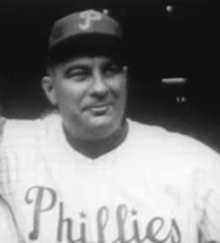
.jpg)
Over 126 seasons, the Phillies franchise has employed 51 managers.[146] The duties of the team manager include team strategy and leadership on and off the field.[147] Seven managers have taken the Phillies to the postseason, with Danny Ozark and Charlie Manuel each leading the team to three playoff appearances. Manuel and Dallas Green are the only Phillies managers to win a World Series: Green in 1980 against the Kansas City Royals; and Manuel in 2008 against the Tampa Bay Rays.[148] Charlie Manuel is the longest-tenured manager in franchise history, with 1,416 games of service in parts of nine seasons (2005–2013).[149] The records and accomplishments of the last seven Phillies' managers are shown below.
| Winning percentage: number of wins divided by number of games managed | |
| Playoff appearances: number of years this manager has led the franchise to the playoffs | |
| Playoff wins: number of wins this manager has accrued in the playoffs | |
| Playoff losses: number of losses this manager has accrued in the playoffs | |
| World Series: number of World Series victories achieved by the manager | |
| Elected to the National Baseball Hall of Fame (‡ denotes induction as manager)[150] | |
| Member of the Philadelphia Baseball Wall of Fame |
| #[a] | Manager | Years | Wins | Losses | Ties | WPct | PA | PW | PL | WS | Ref |
|---|---|---|---|---|---|---|---|---|---|---|---|
| 47 | Jim Fregosi | 1991–1996 | 431 | 463 | 0 | .482 | 1 | 6 | 6 | 0 | [151][152] |
| 48 | Terry Francona | 1997–2000 | 285 | 363 | 0 | .440 | — | — | — | — | [153] |
| 49 | Larry Bowa§[b] | 2001–2004 | 337 | 308 | 0 | .522 | — | — | — | — | [154] |
| 50 | Gary Varsho | 2004 | 1 | 1 | 0 | .500 | — | — | — | — | [155] |
| 51 | Charlie Manuel§ | 2005–2013 | 780 | 636 | 0 | .551 | 5 | 27 | 18 | 1 | [156][157] [158][159] |
| 52 | Ryne Sandberg | 2013–2015 | 119 | 159 | 0 | .428 | — | — | — | — | [160] |
| 53 | Pete Mackanin | 2015–2017 | 174 | 238 | 0 | .422 | — | — | — | — | |
| 54 | Gabe Kapler | 2018–present | 80 | 82 | 0 | .494 | — | — | — | — | |
Statistics current through July 7, 2018
Minor league affiliations
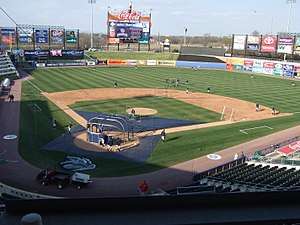
Radio and television
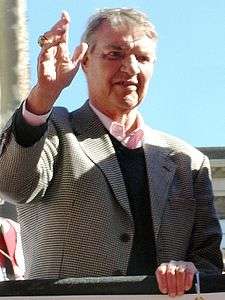
As of 2018, the Phillies' flagship radio stations is WIP-FM (94.1 FM), formerly owned by CBS Radio but since November 2017, owned by Philadelphia-area company Entercom. The broadcasts were discontinued on the former AM flagship station WPHT 1210 in 2016.[161] Scott Franzke and Jim Jackson provide play-by-play on the radio, with Larry Andersen as the color commentator. Meanwhile, NBCUniversal (a unit of Philadelphia-based Comcast) handles local television broadcasts through its properties NBC Sports Philadelphia and WCAU (NBC10). Tom McCarthy calls play-by-play for the television broadcasts, with Ben Davis, Mike Schmidt and John Kruk providing color commentary.
Spanish language broadcasts are on WTTM (1680 AM)[162] with Danny Martinez on play-by-play, and Bill Kulik and Rickie Ricardo on color commentary.
Other popular Phillies broadcasters through the years include By Saam from 1939 to 1975, Bill Campbell from 1962 to 1970, Richie Ashburn from 1963 to 1997, and Harry Kalas from 1971 to 2009.[163] Kalas, a 2002 recipient of the Ford Frick Award and an icon in the Philadelphia area, called play-by-play in the first three and last three innings on television and the fourth inning on the radio until his death on April 13, 2009.
At Citizens Bank Park, the restaurant built into the base of the main scoreboard is named "Harry the K's" in Kalas's honor. After Kalas's death, the Phillies' TV-broadcast booth was renamed "The Harry Kalas Broadcast Booth". It is directly next to the radio-broadcast booth, which is named "The Richie 'Whitey' Ashburn Broadcast Booth". When the Phillies win at home, Kalas' rendition of the song "High Hopes", which he would sing when the Phillies had clinched a playoff berth or advanced in the playoffs, is played as fans file out of the stadium. In addition, when a Phillies player hits a home run a recording of Kalas' famous "That ball is outta here!" home run call is played. The sole exception is Chase Utley, once the subject of another famous Kalas call, "Chase Utley, you are The Man!", which is played when Utley hits a homer.
In 2011, the Phillies unveiled a statue of Harry Kalas at Citizens Bank Park. The statue was funded by Phillies fans and designed and constructed by a Phillies fan.
The Phillies' public-address (PA) announcer is Dan Baker, who started in the 1972 season.[164][165]
In 2011, the Phillies spent $10 million to upgrade the video system at Citizens Bank Park, including a new display screen in left field, the largest in the National League.[166][167]
See also
Footnotes
Article
- a In 1981, a mid-season players' strike split the season. Philadelphia, with the best record in the East Division when play was halted, was declared the first-half division winner. They would, however, lose to the second half-winning Montréal Expos in the NLDS, losing the overall division title. The Phillies' record over the entire season was third-best in the division, 2½ games behind St. Louis and Montréal.
- b The Phillies are the only National League team with two perfect games. Four American League teams have accomplished the feat: New York Yankees (3), Chicago White Sox (2), Cleveland Indians (2), and Oakland Athletics (2).
Retired numbers
- a Grover Cleveland Alexander played in the era before Major League players wore numbers; the Phillies have honored him with the "P" logo from the 1915 season, their first World Series appearance.[114]
- b Chuck Klein wore many numbers while with the Phillies, including 1, 3, 8, 26, 29, and 36. The Phillies wore the Old English "P" during his first six seasons; thus, they chose to use it to honor Klein.[115]
Season records
- a The Finish column lists regular season results and excludes postseason play.
- b The Wins and Losses columns list regular season results and exclude any postseason play.
- c The GB column lists "Games Back" from the team that finished in first place that season. It is determined by finding the difference in wins plus the difference in losses divided by two.
Team managers
- a #: running total of the number of Phillies' managers. Thus, any manager who has two or more separate terms is only counted once.
- b #49: Larry Bowa won the Manager of the Year Award in 2001.[168]
References
- ↑ "Phillies unveil new alternate home uniforms". Phillies.com (Press release). MLB Advanced Media. November 29, 2007. Archived from the original on December 1, 2007. Retrieved February 4, 2018.
- ↑ "2018 Philadelphia Phillies Style Guide". Major League Baseball Properties. January 25, 2018. Retrieved July 25, 2018. (Subscription required (help)).
- ↑ "Nearly traded to the Phillies seven years ago, Saunders 'excited to put on the red pinstripes'". PhillyVoice. 2017-01-25. Retrieved 2017-01-25.
- ↑ "Philadelphia Phillies: A Winning 2017 Or?". Fox Sports. 2017-01-27. Retrieved 2017-01-27.
- ↑ Cridlin, Jay (October 21, 2008). Tampa Bay Times http://www.tampabay.com/features/popculture/know-your-phamous-phillies-phans/864985. Retrieved February 26, 2017.
saw the Phillies with their red pin-stripes
Missing or empty|title=(help) - ↑ "Trustee Biographies | John S. Middleton '77 | Amherst College". www.amherst.edu. Retrieved 2016-11-22.
- ↑ Salisbury, Jim (July 14, 2015). "No longer a team owner, Bill Giles still has Phillies opinions". Comcast Sportsnet Philly L.P. Retrieved July 14, 2015.
- 1 2 Fastenau, Stephen (July 15, 2007). "Phils handed 10,000th loss". Major League Baseball Advanced Media. Retrieved July 1, 2016.
The Phillies in 2007 became the first American professional sports team, and perhaps the first professional sports team in the world in the modern era, to achieve 10,000 franchise losses.
- ↑ Purdy, Dennis (2006). The Team-by-Team Encyclopedia of Major League Baseball. New York City: Workman. ISBN 0-7611-3943-5.
- ↑ "Phillies Timeline: 1800s". History Highlights. Philadelphia Phillies. Retrieved June 5, 2008.
- ↑ "Phillies Timeline: 1910s". History Highlights. Philadelphia Phillies. Retrieved June 5, 2008.
- ↑ "Phillies Timeline: 1930s". History Highlights. Philadelphia Phillies. Retrieved June 5, 2008.
No period in Phillies history was more bizarre than the decade of the 1930s. On the one hand, the club had some of its worst teams. On the other hand, it had some of its best players.
- ↑ "Phillies Timeline: 1940s". History Highlights. Philadelphia Phillies. Retrieved June 4, 2008.
- 1 2 "Phillies Timeline: 1950s". History Highlights. Philadelphia Phillies. Retrieved June 4, 2008.
- ↑ Goldstein, Richard (November 23, 1998). "Dick Sisler, 78, Whose Homer Won '50 Pennant for Phillies". The New York Times. Retrieved June 5, 2008.
- ↑ Fleming, Frank (April 9, 2006). "Philadelphia Athletics". Retrieved June 4, 2008.
- ↑ Hochman, Stan (July 1972). "Robin Roberts Remembers the 'Whiz Kids'". Baseball Digest. Lakeside Publishing Company. 31 (7): 35–38. ISSN 0005-609X.
- ↑ Zimniuch, Fran (2005). "Big Leagues, Here I Come". Richie Ashburn Remembered. Sports Publishing LLC. p. 23. ISBN 1-58261-897-6. Retrieved October 29, 2009.
- ↑ "Philadelphia Phillies Team History & Encyclopedia". Baseball-Reference.com. Sports Reference LLC. Retrieved October 28, 2009.
- ↑ Threston, Christopher (2003). The integration of baseball in Philadelphia. McFarland. p. 57. ISBN 0-7864-1423-5. Retrieved October 29, 2009.
- ↑ "Struck Out: The Fall of the 1964 Phillies". Philadelphia:The Great Experiment. January 24, 2013. Archived from the original on February 21, 2016. Retrieved April 4, 2016.
- ↑ "Phillies Timeline: 1960s". History Highlights. Philadelphia Phillies. Retrieved June 5, 2008.
- ↑ McCoy, Hal (2014-06-13). "Father's Day to remember: Bunning's perfect game of '64". Fox Sports. Fox News. Archived from the original on 2015-08-18. Retrieved 4 September 2015.
- ↑ ESPN Greatest 3rd Basemen
- ↑ Sports Illustrated Top 3rd Basemen
- ↑ "Phillies Timeline: 1970s". History Highlights. Philadelphia Phillies. Retrieved June 5, 2008.
- 1 2 "Phillies Timeline: 1980s". History Highlights. Philadelphia Phillies. Retrieved June 5, 2008.
- ↑ Sandomir, Richard (18 October 2014). "Baseball World Series: Postseason Vanishing From Broadcast Networks". The New York Times. CLXIV (56, 657): D4. Retrieved 25 October 2014.
- ↑ "Postseason Index". Baseball-Reference.com. Retrieved June 5, 2008.
- ↑ "Phillies Timeline: 1990s". History Highlights. Philadelphia Phillies. Retrieved June 5, 2008.
- ↑ "1993 World Series (1990s)". Baseball Almanac. Retrieved June 5, 2008.
- ↑ "History: Phillies Year-by-Year Results". Phillies. Retrieved June 5, 2008.
- ↑ "Citizens Bank Park". Citizens Bank. Retrieved June 5, 2008.
- ↑ Shpigel, Ben (October 7, 2007). "Rockies Sweep Phillies to Keep Up Memorable Run". The New York Times. Retrieved June 5, 2008.
- ↑ Cherry, Gene; Ed Osmond (September 28, 2008). "Phillies claim NL East but wildcard spot up for grabs". Reuters. Retrieved September 28, 2008.
- ↑ Salisbury, Jim (December 7, 2009). "Organization of the Year: Philadelphia Phillies / Philadelphia completes an amazing turnaround". Baseball America, Inc. Retrieved September 21, 2010.
- ↑ "Phillies acquire Halladay". MLB.com. December 16, 2009. Retrieved December 17, 2009.
- ↑ Mayo, Jonathan & Winston, Lisa (December 16, 2009). "Seven prospects involved in blockbuster". MLB.com. Archived from the original on December 20, 2009. Retrieved December 17, 2009.
- ↑ Bastian, Jordan (May 11, 2010). "Jays' set vs. Phillies moved to Philadelphia". Major League Baseball. Retrieved May 12, 2010.
- ↑ Zolecki, Todd; Schonbrun, Zach (June 25, 2010). "Howard is first DH at Citizens Bank Park". Philadelphia Phillies. MLB. Retrieved June 26, 2010.
- ↑ Fitzpatrick, Frank (June 26, 2011). "Golden era for Phila. baseball?: Yes, it is. But the city also had three others". The Philadelphia Inquirer. Philadelphia media Network. Retrieved June 27, 2011.
- ↑ Westcott, Rich (October 1, 2010). "The best Phillies of all time". Philadelphia Phillies. MLB. Retrieved October 1, 2010.
- ↑ 'Duk (April 20, 2011). "Phillies' injury plague sends Ryan Howard to the 15-day DL – Big League Stew – MLB Blog – Yahoo! Sports". Sports.yahoo.com. Retrieved April 19, 2012.
- ↑ Ed Price %BloggerTitle% (August 17, 2010). "Phillies Activate Chase Utley from DL". Mlb.fanhouse.com. Retrieved April 19, 2012.
- ↑ "Jimmy Rollins goes on 15-day DL with calf injury". USA Today. April 14, 2010.
- ↑ Wed, Apr 1810:15 PM ET (February 4, 2003). "Shane Victorino Stats, News, Pictures, Bio, Videos – Philadelphia Phillies". ESPN. Retrieved April 19, 2012.
- ↑ Wed, Apr 1810:15 PM ET. "Carlos Ruiz Stats, News, Pictures, Bio, Videos – Philadelphia Phillies". ESPN. Retrieved April 19, 2012.
- ↑ "Regular Season Standings". MLB. Retrieved April 19, 2012.
- ↑ "Phillies Clinch Fourth Consecutive Division Title". Mlb.fanhouse.com. September 27, 2010. Retrieved April 19, 2012.
- 1 2 "Philadelphia Phillies 2011 Schedule – Phillies Home and Away". ESPN. January 2, 2011. Retrieved April 19, 2012.
- ↑ Zolecki, Todd (September 27, 2010). "Phour! Phils' NL East dominance continues". Philadelphia Phillies. MLB. Retrieved September 28, 2010.
- ↑ "Cincinnati Reds vs. Philadelphia Phillies – Recap". ESPN. October 6, 2010. Retrieved October 7, 2010.
- ↑ "Phillies clinch 5th straight NL East title after Roy Oswalt handles Cards". ESPN. Retrieved September 18, 2011.
- ↑ Brookover, Bob (September 29, 2011). "Marathon Milestones: Manuel, Phillies Break Team Records". The Philadelphia Inquirer. p. A1.
- ↑ "2013 Philadelphia Phillies". Baseball Reference. Retrieved 26 July 2014.
- ↑ "MacPhail to be Phillies president after season". MLB.com. Retrieved 2 March 2017.
- ↑ "Philadelphia Phillies vs. Chicago Cubs – Box Score – July 25, 2015 – ESPN". Retrieved July 25, 2015.
- ↑ Eric Stephen. "Cole Hamels pitches no-hitter at Wrigley Field amid trade rumors". SBNation.com. Vox Media. Retrieved July 25, 2015.
- ↑ Taylor, Jean-Jacques (August 1, 2015). "Cole Hamels quickly going to work for Texas after 8-player trade finalized". ESPN. Retrieved October 2, 2015.
- ↑ Corcoran, Cliff (August 1, 2015). "Rangers land Cole Hamels from Phillies in move for 2016 and beyond". Sports Illustrated. Retrieved October 2, 2015.
- ↑ "Who is Andy MacPhail?". Archived from the original on December 22, 2015. [? Blank page]
- ↑ Uniforms and Logos. Philadelphia Phillies official website. Retrieved August 14, 2011.
- ↑ Vitez, Michael (August 29, 2011). "Baseball and socks appeal". The Philadelphia Inquirer. Retrieved September 2, 2011.
Every Phillie wears high socks, but most hide them with long pants.
- 1 2 Okkonen, Mark. "Dressed to the Nines: Uniform Database". National Baseball Hall of Fame. Retrieved June 10, 2008.
- ↑ Okkonen, Mark. "Dressed to the Nines: Uniform Database". National Baseball Hall of Fame. Retrieved June 15, 2009.
- ↑ Zenz, Jay. "Phillies unveil alternate uniforms". Scout.com. Archived from the original on June 9, 2008. Retrieved June 10, 2008.
- ↑ Okkonen, Mark. "Dressed to the Nines: Uniform Database (1979)". National Baseball Hall of Fame. Retrieved June 7, 2008.
- ↑ Lukas, Paul (August 23, 2007). "Uni Watch: One and done". Uni Watch. ESPN. Retrieved October 13, 2009.
- ↑ "Box Score of Game played on Saturday, May 19, 1979, at Veteran's Stadium". Retrieved October 13, 2009.
- ↑ "Baseball almanac entry on baseball uniforms". baseball-almanac.com. Retrieved June 6, 2008.
- ↑ Okkonen, Mark. "Dressed to the Nines: Uniform Database (1994)". National Baseball Hall of Fame. Retrieved June 7, 2008.
- ↑ "Phils Resolve Blue-cap Crisis With An Agreement: Hats Off On Sundays". Articles.philly.com. 1994-05-01. Retrieved 2013-06-27.
- ↑ "Phils Shake Off Blues, Beat Marlins Danny Jackson Pitched Eight Solid Innings For His 10th Victory. Pratt Tripled In Subbing For Daulton". philly.com. 1994-06-30. Retrieved 2013-06-27.
- ↑ Bondy, Filip (April 11, 2008). "Mets-Phillies rivalry looking like what Mets-Braves used to be". New York Daily News. Retrieved June 15, 2009.
- ↑ Westcott, Rich (2010). Philadelphia Phillies Past & Present. MVP Books. p. 10. ISBN 9781610600989. Retrieved July 15, 2011.
- ↑ Bondy, Filip (May 24, 2006). "Despite long game, rivalry long way off". New York Daily News. Retrieved January 11, 2010.
- ↑ Radano, Mike (September 17, 2011). "High Phive: Phils clinch fifth straight East title". Philadelphia Phillies. MLB. Retrieved September 18, 2011.
- ↑ Schultz, Jeff. "If Braves send message to Phillies, it will be done nicely". Atlanta Journal Constitution. Archived from the original on April 11, 2011. Retrieved May 26, 2011.
- ↑ Woolsey, Matt (April 28, 2009). "In Depth: Baseball's Most Intense Rivalries". Forbes.
- ↑ Collier, Gene (July 4, 2005). "Pirates—Phillies: A Rivalry Lost and Missed". Pittsburgh Post-Gazette. p. D1.
- 1 2 Von Benko, George (July 7, 2005). "Notes: Phils–Pirates rivalry fading". Philadelphia Phillies. MLB. Archived from the original on July 14, 2011. Retrieved January 3, 2011.
- 1 2 Hagen, Paul (April 4, 2012). "Pirates hope to get to where Phillies are". MLB.com. Retrieved April 8, 2012.
- ↑ "Pirates perform rare three-peat feat 4–2". USA Today. September 28, 1992. p. 5C.
- ↑ Collier, Gene (September 27, 1993). "Pirates, Phillies Have Owned the Outgoing NL East Division". Pittsburgh Post-Gazette. p. D1.
- 1 2 "It's Philly vs. the Burgh". Pittsburgh Post-Gazette. May 11, 2008. p. B1.
- ↑ "Flyers, Penguins renew nasty playoff rivalry". NHL.com. Associated Press. April 14, 2009. Retrieved March 22, 2011.
- ↑ "2014 Promotional Schedule".
- ↑ Gordon, Robert; Burgoyne, Tom (2004). Movin' on Up: Baseball and Phialdephia Then, Now, and Always. B B& A Publishers. p. 128. ISBN 0-9754419-3-0.
- 1 2 Baseball Reference Awards – MVP & CYA Accessed May 30, 2008.
- ↑ Baseball Reference Awards – ROY Accessed May 30, 2008.
- ↑ "ESPN – Howard beats out Pujols to win NL MVP Award". ESPN. November 22, 2006. Retrieved April 19, 2012.
- ↑ See: List of Major League Baseball single-game home run leaders § Players.
- ↑ "Dallas Green Statistics and History". Baseball-Reference.com. Retrieved September 19, 2009.
- ↑ "Dallas Green Managerial Record". Baseball-Reference.com. Retrieved September 19, 2009.
- ↑ Mandel, Ken (March 8, 2007). "Vukovich passes away at 59". Phillies.MLB.com. Archived from the original on August 29, 2009. Retrieved September 19, 2009.
- ↑ "Juan Samuel Statistics and History". Baseball-Reference.com. Retrieved September 19, 2009.
- ↑ Gurian-Peck, David. "Kalas to be inducted into Wall of Fame". Phillies.MLB.com. Sports Reference LLC. Retrieved September 19, 2009.
- ↑ Zolecki, Todd; Schonbrun, Zach (June 23, 2010). "Daulton is Phils' Wall of Fame inductee". Phillies.MLB.com. Archived from the original on June 28, 2010. Retrieved June 23, 2010.
- ↑ Parrillo, Ray (August 13, 2011). "Kruk takes his place on Wall of Fame". Philly.com. Philadelphia Media Network. Archived from the original on August 14, 2011. Retrieved August 13, 2011.
- ↑ "Lieberthal Selected to Phillies' Wall of Fame". Philly.com. Philadelphia Media Network. June 7, 2012. Archived from the original on August 14, 2011. Retrieved June 7, 2012.
- ↑ "Curt Schilling enshrined, but Darren Daulton star of night". Philly.com. Philadelphia Media Network. August 3, 2013. Archived from the original on August 14, 2011. Retrieved August 3, 2013.
- ↑ "'Humbled' Manuel honored by Phillies". Philly.com. Philadelphia Media Network. August 10, 2014. Retrieved August 10, 2014.
- ↑ Needelman, Joshua (August 4, 2018). "Doc takes place on Phillies Wall of Fame". MLB.com. Retrieved August 5, 2018.
- ↑ Zolecki, Todd (August 3, 2018). "Former GM Gillick to join Phillies Wall of Fame". MLB.com. Retrieved August 5, 2018.
- ↑ For list of Hall of Famers and years with Phillies, see National Baseball Hall of Famers. Philadelphia Phillies official website. Retrieved August 14, 2011.
- ↑ Carr, Samantha (December 6, 2010). "Emotional Election". National Baseball Hall of Fame and Museum. Retrieved January 5, 2011.
- ↑ Retired Numbers. Philadelphia Phillies official website. Retrieved August 14, 2011.
- ↑ The Official Site of The Philadelphia Phillies: History: Richie Ashburn Retrieved July 19, 2008.
- ↑ The Official Site of The Philadelphia Phillies: History: Jim Bunning Retrieved July 19, 2008.
- ↑ The Official Site of The Philadelphia Phillies: History: Mike Schmidt Retrieved July 19, 2008.
- ↑ The Official Site of The Philadelphia Phillies: History: Steve Carlton Retrieved July 19, 2008.
- ↑ The Official Site of The Philadelphia Phillies: History: Robin Roberts Retrieved July 19, 2008.
- ↑ The Official Site of The Philadelphia Phillies: History: Phillies Retired Numbers Retrieved July 19, 2008.
- 1 2 The Official Site of The Philadelphia Phillies: History: Grover Cleveland Alexander Retrieved July 19, 2008.
- 1 2 The Official Site of The Philadelphia Phillies: History: Chuck Klein Retrieved July 19, 2008.
- 1 2 3 Horan, Kevin (July 28, 2008). "Phillies hold Phestival against ALS". Philadelphia Phillies. Retrieved July 29, 2008.
- ↑ "Phillies Phestival raises record amount for ALS". 6-ABC. Associated Press. July 28, 2008. Retrieved July 29, 2008.
- ↑ "The ALS Association, Greater Philadelphia". The ALS Association. Archived from the original on September 15, 2008. Retrieved July 29, 2008.
- ↑ Santoliquito, Joseph (May 21, 2007). "Phillies raise money, awareness for ALS". Philadelphia Phillies. Retrieved July 29, 2008.
- ↑ "Curt's Pitch of ALS 2008". The ALS Association. Retrieved July 29, 2008.
- ↑ 16th annual ENGIE Teacher Appreciation Night. MLB. "Each year, the Phillies select 10 area teachers nominated by current and former students, parents and peers to honor as Teacher All-Stars." Retrieved June 6, 2016.
- ↑ Philadelphia Phillies year-by-year results (including annual attendance). Philadelphia Phillies official website. Retrieved August 14, 2011.
- ↑ "phillies". prezi.com. Retrieved 2018-01-09.
- ↑ Chuck, Bill; Jim Kaplan (2008). Walk Offs, Last Licks, and Final Outs:Baseball's Grand (and Not-So-Grand) Finales. Skokie, Illinois: ACTA Publications. p. 130. ISBN 9780879463427.
- ↑ Longman, Jeré (2006). If Football's a Religion, Why Don't We Have a Prayer?. New York: HarperCollins Publishers. ISBN 978-0-06-084373-1.
- ↑ "Eagles, Phillies top GQ list of 'Worst Fans in America' - Philly". Retrieved 29 March 2018.
- ↑ "Retrosheet Boxscore: Dodgers 6, Phillies 5". Retrosheet. October 7, 1977. Retrieved June 8, 2008.
- ↑ "Archives - Philly.com".
- ↑ Pappas, Doug. "Spring 1998: The J. D. Drew Saga". Archived from the original on June 25, 2007. Retrieved June 4, 2008.
- ↑ "'They were throwing batteries'". CNN Sports Illustrated. August 11, 1999. Retrieved March 8, 2007.
- ↑ Barra, Allen (October 26, 2004). "Curses!". The Village Voice. Retrieved June 8, 2008.
- 1 2 Westcott, Rich (2005). Veterans Stadium: field of memories. Temple University Press. p. 100. ISBN 978-1-59213-428-1.
- ↑ "The Phillies Phanatic". Philadelphia Phillies. Retrieved July 19, 2008.
- ↑ Girandola, Chris (February 22, 2008). "Phillies, phans enjoy phestivities". Philadelphia Phillies. Retrieved July 19, 2008.
- ↑ Zolecki, Todd (August 19, 2010). "Phillies host 100th consecutive sellout". Philadelphia Phillies. MLB. Retrieved August 30, 2010.
- ↑ Gelb, Matt (4 April 2011). "Martinez gets start, then gets his first hit". The Philadelphia Inquirer – via Proquest Newstand.
- ↑ "Attendance up by under 1 percent". ESPN. Associated Press. September 29, 2011. Retrieved September 30, 2011.
The ... Phillies led baseball's attendance chart for the first time ....
- ↑ "Baseball attendance increased from 2010". Yahoo! Sports. The Sports Xchange. September 29, 2011. Retrieved September 30, 2011.
- ↑ "Philadelphia Phillies Lead MLB in Attendance For First Time Ever". RantSports. September 29, 2011. Archived from the original on June 13, 2013. Retrieved September 30, 2011.
- ↑ "Phillies set attendance record". Philadelphia Business Journal. American City Business Journals, Inc. September 23, 2011. Retrieved September 30, 2011.
- ↑ "MLB Attendance Report - 2016". ESPN: MLB. ESPN. Retrieved June 6, 2016.
- ↑ "Another indication that the Phillies are braced for an offseason star search". The Inquirer. August 31, 2018. Retrieved September 9, 2018. Text " Extra Innings" ignored (help)
- ↑ . Crossing Broad. August 3o, 2018 Phillies Move Up Aaron Nola’s Start to Sunday, Promptly Unveil a Nola Promo for Sunday https://www.crossingbroad.com/2018/08/the-phillies-move-up-aaron-nolas-start-to-sunday-promptly-unveil-a-nola-promo-for-sunday.htmltitle=The Phillies Move Up Aaron Nola’s Start to Sunday, Promptly Unveil a Nola Promo for Sunday Check
|url=value (help). Retrieved September 9, 2018. Check date values in:|date=(help); Missing or empty|title=(help) - ↑ "Major League Baseball Cy Young Award winners". MLB.com. Retrieved 2008-04-15.
- ↑ name="bbref"/>"Philadelphia Phillies Team History & Encyclopedia". Baseball-Reference.com. Retrieved October 5, 2018.
- ↑ "Philadelphia Phillies Managerial Register". Baseball-Reference.com. Retrieved July 23, 2008.
- ↑ "Manager: Definition". Dictionary.Reference.com. The American Heritage Dictionary of the English Language. 2006. Retrieved December 29, 2008.
- ↑ "Philadelphia Phillies Team History". Baseball-Reference.com. Retrieved July 25, 2008.
- ↑ "Charlie Manuel Managerial Record". Baseball-Reference.com. Retrieved May 18, 2016.
- ↑ "Baseball Hall of Fame Inductees". Baseball-Reference.com. Retrieved December 29, 2008.
- ↑ "Jim Fregosi Managerial Record". Baseball-Reference.com. Retrieved July 25, 2008.
- ↑ "1993 Philadelphia Phillies". Baseball-Reference.com. Retrieved July 25, 2008.
- ↑ "Terry Francona". Baseball-Reference.com. Retrieved July 25, 2008.
- ↑ "Larry Bowa Managerial Record". Baseball-Reference.com. Retrieved July 25, 2008.
- ↑ "Gary Varsho Managerial Record". Baseball-Reference.com. Retrieved July 25, 2008.
- ↑ "Charlie Manuel Managerial Record". Baseball-Reference.com. Retrieved July 25, 2008.
- ↑ "2007 Philadelphia Phillies". Baseball-Reference.com. Retrieved July 25, 2008.
- ↑ "2008 Philadelphia Phillies". Baseball-Reference.com. Retrieved January 16, 2009.
- ↑ "2009 Philadelphia Phillies". Baseball-Reference.com. Retrieved January 16, 2009.
- ↑ "Ryne Sanberg Managerial Record". Baseball-Reference.com. Retrieved June 26, 2015.
- ↑ New deal makes WIP the Phillies' exclusive radio home in Philadelphia. The Philadelphia Inquirer, February 17, 2016. Retrieved April 24, 2016.
- ↑ "Phillies Radio Network". Philadelphia Phillies. Retrieved 2009-03-07.
- ↑ Goldstein, Richard (April 13, 2009). "Harry Kalas, Popular Voice of Phillies, Dies at 73". The New York Times. p. B16. Retrieved May 3, 2009.
- ↑ Shute, Mike (September 30, 2011). "After 40 years with the Phillies, Baker's voice still choice". Courier-Post. Retrieved October 6, 2011.
- ↑ Jensen, Mike (October 18, 2010). "One pronounced voice: The Phillies' PA announcer prides himself on accuracy and emphasis". The Philadelphia Inquirer. Retrieved October 19, 2010.
- ↑ Brookover, Bob (January 20, 2011). "Phils upgrading their video board". Philly.com. Philadelphia Media Network. Retrieved January 22, 2011.
- ↑ Hagen, Paul (January 20, 2011). "Phillies will have biggest video board in National League". Philly.com. Philadelphia Media Network. Retrieved January 22, 2011.
- ↑ "MLB Awards (Manager of the Year)". Major League Baseball. Retrieved July 28, 2008.
External links
| Wikimedia Commons has media related to Philadelphia Phillies. |
| Awards and achievements | ||
|---|---|---|
| Preceded by Pittsburgh Pirates 1979 Boston Red Sox 2007 |
World Series champions Philadelphia Phillies 1980 2008 |
Succeeded by Los Angeles Dodgers 1981 New York Yankees 2009 |
| Preceded by Boston Braves 1914 Brooklyn Dodgers 1949 Pittsburgh Pirates 1979 St. Louis Cardinals 1982 Atlanta Braves 1992 Colorado Rockies 2007 |
National League champions Philadelphia Phillies 1915 1950 1980 1983 1993 2008 and 2009 |
Succeeded by Brooklyn Dodgers 1916 Brooklyn Dodgers 1951 Los Angeles Dodgers 1981 San Diego Padres 1984 Atlanta Braves 1995 San Francisco Giants 2010 |
| Preceded by Pittsburgh Pirates 1975 Pittsburgh Pirates 1979 St. Louis Cardinals 1982 Pittsburgh Pirates 1992 New York Mets 2006 |
National League East Division champions Philadelphia Phillies 1976, 1977 and 1978 1980 1983 1993 2007, 2008, 2009, 2010 and 2011 |
Succeeded by Pittsburgh Pirates 1979 Montreal Expos 1981 Chicago Cubs 1984 Atlanta Braves 1995 Washington Nationals 2012 |
| Preceded by Seattle Mariners |
Last MLB team to pitch a team no hitter September 1, 2014 |
Succeeded by Incumbent |

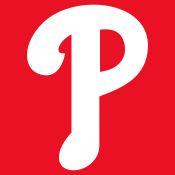

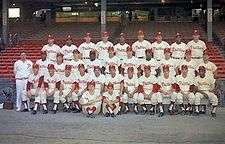


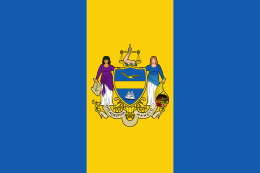

.jpg)
